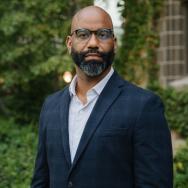“C /O! / I need a med-tech / I can’t taste or smell,” Jimmie Moody’s poem starts with a plea. “Yelled throughout the cellhouse / But nobody coming.”
Moody’s “Untitled,” one of many pieces brought together by curator Michelle Daniel Jones, is currently on display in the art exhibition “Makes Me Wanna Holla: Art, Death & Imprisonment.”
Open through Sept. 10 at the Logan Center for the Arts, the exhibition explores the injustices of the carceral system through the voices and art of those who have experienced them firsthand.
The exhibition culminates a yearlong “Artist for the People” Practitioner fellowship for Daniel Jones and artist Dorothy Burge, co-hosted by UChicago’s Center for the Study of Race, Politics, and Culture (CSRPC) and the Pozen Center Human Rights Lab.
“This fellowship is centered on artists whose work engages with the carceral system,” said Alice Kim, director of the Beyond Prisons Project at CSRPC. “The work of Michelle and Mama Dorothy is so powerful because it's lifting up and making visible who is behind the prison wall.”
Walking into the space, visitors find themselves among Burge’s colorful series of quilted portraits—titled “Won't You Help to Sing These Songs of Freedom?”—depicting incarcerated survivors of Chicago police torture and other stories of resilience.
Daniel Jones, with activist group Mourning Our Losses, curated a traveling memorial of over 60 pieces of visual art, poetry, music and oral history interviews. “We Shall Remember” features current and formerly incarcerated artists speaking to the horrors of the COVID-19 pandemic while honoring those lives lost behind bars.
“I think the end result is just so intense and powerful to see all the different voices, different perspectives,” said Tracye Matthews, CSRPC’s executive director.
Who gets remembered?
In the early days of the pandemic, artist and scholar Michelle Daniel Jones was terrified for her friends behind bars. COVID was sweeping through prisons with lightning speed—those stuck in cramped cells some of the most vulnerable to infection.
Daniel Jones and a group of volunteers petitioned government officials for early releases. Their requests were denied. Since the viral outbreak, over half a million people in state and federal prisons have contracted COVID. At least 3,000 have died.
Through grief and anger, these organizers officially formed Mourning Our Losses in April 2020. With a digital memorial website, they sought to mourn those who had died from the virus, while continuing to advocate for the release of those still behind bars.
“We wanted to make sure people understand that people were dying significantly from this pandemic,” said Daniel Jones, co-founder of Mourning Our Losses. “But also raise the reality that a lot of the people who die in prison often have the silent unremarked death.”
The Mourning Our Losses team put out a call for submissions, seeking all styles of art that engaged with the pandemic and incarceration. The careful search resulted in 50 contributing artists, most of whom are formerly or currently incarcerated.
Each piece on display reflects a painstaking process filled with forms, background checks, communication hurdles and other hallmarks of prison bureaucracy. As a first-time curator, Daniel Jones was also acutely aware of how every participating artist was treated throughout the process.
“We wanted to make sure that you are identified the way you want—that you receive some compensation—and we take care of your work once the show is over,” Daniel Jones said. “That was hugely important to us.”
The traveling memorial “We Shall Remember” weaves all these voices together, creating a chorus resounding with despair, resilience, hope and pain of friends lost.
“While at Stateville Prison in Illinois,” Carlos Ayala said in his artist’s statement, “I saw individuals I knew for twenty years pass away from COVID-19. So, the opportunity to represent them is an honor.”
The exhibition team hopes that, through immersive art, visitors will be able to engage with people’s experiences in a way that endless news stories and statistics can’t get at. Hopefully, it will even propel them to action.
Won’t You Help to Sing These Songs of Freedom?
Quiltivist Dorothy Burge, known to friends as Mama Dorothy, first fully understood the power of quilts when she created one in response to the killing of Trayvon Martin—the unarmed teen who was shot to death in Sanford, Florida, while walking home in 2012.
“Doing that was kind of life-changing to me,” said Burge, who comes from a long line of Mississippi quilters. “It just really was a way for me to say, ‘This is what I think about what happened to us. This is what's important.’”
She brought the quilt commemorating Trayvon to protests, to classrooms full of students to tell his story. Since then, when something hits her—something that needs action—she makes a quilt.
The exhibition is filled with many powerful quilted stories. A series of portraits paired with oral histories depicts survivors of torture at the hands of former Chicago Police Commander Jon Burge (no relation to Dorothy Burge) and his Midnight Crew.
During the 1970s and ’80s, station officers of Area 2 waged a reign of terror across the South Side. City officials ignored countless reports of people being beaten, suffocated, burned and electrocuted by Jon Burge and his officers to coerce confessions—many of them false.
When the claims finally came to light, the Midnight Crew was found responsible for the torture of at least 118 people held in custody. Many survivors are still behind bars.
Alongside organizations like Chicago Torture Justice Memorials, Dorothy Burge has sought justice for survivors for decades. Recently, Chicago Mayor Brandon Johnson pledged funding for memorials—though Dorothy Burge says the fight will not stop until they are built.
“We're still fighting for reparations,” she said. “We're still fighting to get people out who were incarcerated because they were tortured into confessions.”
Additionally, there are quilted tributes to two African American trans women who were murdered in 2022; and another to Albert Woodfox, one of the Angola 3 who survived nearly 44 years in solitary confinement.
“For me to be able to take people to see the quilt and say, ‘Let me tell you who this person is. Let me tell you how this person overcame all the hardships,’” Dorothy Burge said. “I think that's a powerful, powerful message to young people.”
“Both artists are really saying these are ongoing, live issues that demand our attention,” Kim said. “So ‘Makes Me Wanna Holla’ is a perfect title.”
—“Makes Me Wanna Holla: Art, Death & Imprisonment" is open through Sept. 10. Visit the exhibition website to learn about additional programming.

